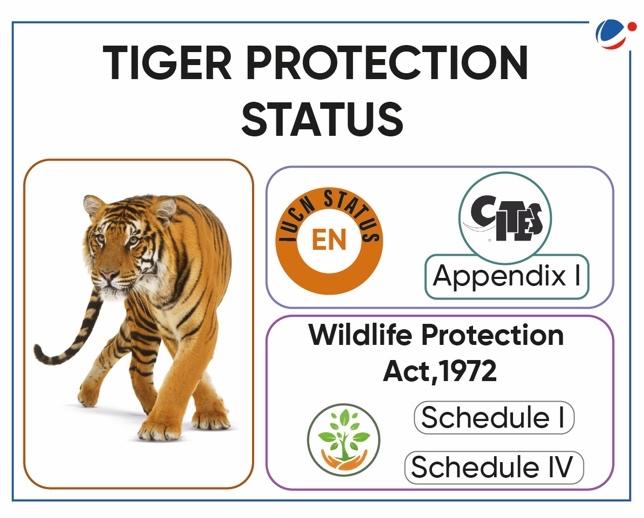Why in the News?
The Indian government officially marked 2023 as the 50th year of ‘Project Tiger’.
About Project Tiger
- A Centrally Sponsored Scheme of the Ministry of Environment, Forests and Climate Change (MoEFCC), launched in 1973.
- Initially launched in 9 Tiger reserves (TRs) in different states of India.
- Provides central assistance to tiger range States for in-situ conservation of tigers in designated tiger reserves.
- Objective: To ensure the maintenance of a viable population of tigers in India for scientific, economic, aesthetic, cultural and ecological values.
- Project Tiger has a holistic ecosystem approach. Though the main focus is on the flagship species tiger, the project strives to maintain the stability of ecosystems by also supporting abundant prey populations.
- Implementing Agency: National Tiger Conservation Authority (NTCA).
- NTCA was launched in 2005, following the recommendations of the Tiger Task Force. It was given statutory status by 2006 amendment of Wildlife (Protection) Act, 1972.
- Funding pattern: 60% Central Assistance is being made available to States for expenditure on all non-recurring items.
- For recurring items, Central Assistance is restricted to 50% of the expenditure, while a matching grant is provided by the Project States.
- North Eastern and Himalayan States are provided 90% central assistance in both cases.
- Project Tiger and Project Elephant were merged as Project Tiger & Elephant.
- Activities undertaken under Project Tiger
- Establishment and development of Tiger Reserves: 55 tiger reserves. (Veerangana Durgavati Tiger Reserve and Dholpur – Karauli Tiger Reserve were declared in 2023)
- Core-buffer strategy to manage tigers: Core areas have the legal status of a national park or a sanctuary.
- Whereas buffer or peripheral areas are a mix of forest and non-forest land, managed as a multiple-use area.
- Technological advancements: The e-Bird project uses Unmanned Aerial Vehicles (UAV) for Surveillance and Monitoring.
- NTCA conducts assessment using the application M-STrIPES (Monitoring System for Tigers Intensive Protection & Ecological Status).
- Special Tiger Protection Force (STPF): Deployed in several TRs for focused anti-poaching operations.
The conservation of tigers in India can be divided into two phases.
|

Challenges in Tiger Conservation
- Habitat Loss and Fragmentation: Out of the approximately four lakh square kilometres of forests in tiger states, only one-third are in relatively healthier condition (Status Tiger Report 2022).
- Human-Wildlife Conflict: As human populations expand and encroach upon tiger habitats, conflicts arise.
- Poaching and Illegal Wildlife Trade: Poachers target tigers for their skins, bones, and other body parts.
- Climate change: Shifting temperatures are altering the habitats of tigers in the Himalayan States, Sundarbans and Western Ghats.
- Climate change accelerates, and wildfires are becoming more frequent in ecosystems that do not typically experience a fire season.
- Monitoring: TR such as Mukundra, Ranthambore, Nagarhole, etc. are situated along the boundaries of the state, which creates an issue of monitoring as the animal moves from one generation to another.
- Other: Tigers reserves are also threatened by invasive plant species such as Lantana camara.

Way ahead
- Habitat Protection and Restoration: Strengthen efforts to protect and expand tiger habitats.
- Establish and maintain wildlife corridors to connect fragmented habitats.
- Community Involvement and Awareness: Engage local communities in conservation efforts through education and awareness programs.
- Promote sustainable livelihoods for communities living near tiger habitats to reduce dependence on natural resources.
- Anti-Poaching Measures: Enhance law enforcement and anti-poaching efforts with better training, equipment, and technology.
- Collaborate with local communities to gather intelligence and report illegal activities.
- Impose severe penalties and consequences for wildlife crimes to act as a deterrent.
- Climate Change Mitigation: Support research on the impacts of climate change on tiger habitats and populations.
- Public-Private Partnerships: Encourage private sector involvement in tiger conservation through corporate social responsibility (CSR) initiatives.
About Tiger 
|






